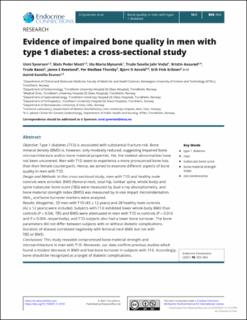| dc.description.abstract | Objective Type 1 diabetes (T1D) is associated with substantial fracture risk. Bone mineral density (BMD) is, however, only modestly reduced, suggesting impaired bone microarchitecture and/or bone material properties. Yet, the skeletal abnormalities have not been uncovered. Men with T1D seem to experience a more pronounced bone loss than their female counterparts. Hence, we aimed to examine different aspects of bone quality in men with T1D. Design and Methods In this cross-sectional study, men with T1D and healthy male controls were enrolled. BMD (femoral neck, total hip, lumbar spine, whole body) and spine trabecular bone score (TBS) were measured by dual x-ray absorptiometry, and bone material strength index (BMSi) was measured by in vivo impact microindentation. HbA1c and bone turnover markers were analyzed. Results Altogether, 33 men with T1D (43 ± 12 years) and 28 healthy male controls (42 ± 12 years) were included. Subjects with T1D exhibited lower whole-body BMD than controls (P = 0.04). TBS and BMSi were attenuated in men with T1D vs controls (P = 0.016 and P = 0.004, respectively), and T1D subjects also had a lower bone turnover. The bone parameters did not differ between subjects with or without diabetic complications. Duration of disease correlated negatively with femoral neck BMD but not with TBS or BMSi. Conclusions This study revealed compromised bone material strength and microarchitecture in men with T1D. Moreover, our data confirm previous studies which found a modest decrease in BMD and low bone turnover in subjects with T1D. Accordingly, bone should be recognized as a target of diabetic complications. | en_US |

